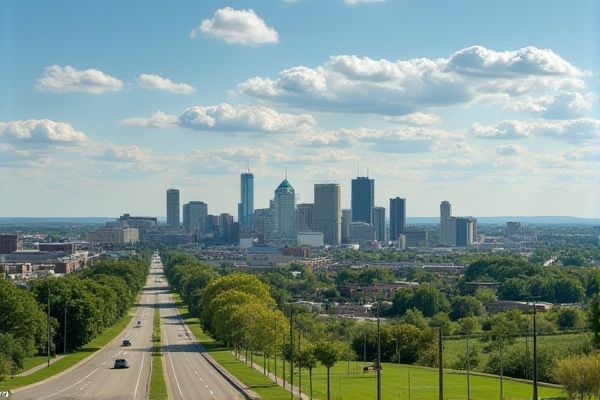
Insights from South Dakota residents and expatriate communities: Climate: Harsh winters, mild summers. Cost of Living: Generally affordable. Job Market: Agriculture, healthcare, tourism sectors. Outdoor Activities: Hiking, fishing, hunting popular. Cultural Heritage: Native American influence significant. Community Spirit: Strong, close-knit communities. Education: Quality public schools, universities. Healthcare: Good facilities, accessible services. Transportation: Car necessary, limited public options. Festivals: Yearly state fairs, cultural events.
Climate: Harsh winters, mild summers.
South Dakota residents, particularly in the western part of the state, experience milder winters due to the "Banana Belt" effect around the Black Hills, which shields the area from harsh winter weather and captures warm Chinook winds, contrasting with the harsh winters and colder temperatures in other parts of the state. Expatriate communities may find the climate varied, with Rapid City and surrounding areas offering more favorable winter conditions compared to the rest of South Dakota.
Cost of Living: Generally affordable.
South Dakota boasts a generally affordable cost of living, with an average annual personal consumption cost of $48,997 and a cost of living index of 91.2, making it the 13th lowest in the country. Housing costs are notably economical, with median monthly rents spanning from $507 for a studio to $1,557 for a four-bedroom home, and typical home values are approximately $307,799. Discover detailed insights by visiting the Cost of Living in South Dakota page for a comprehensive breakdown of expenses in the region.
Job Market: Agriculture, healthcare, tourism sectors.
In South Dakota, the job market is robust in the agriculture, healthcare, and tourism sectors. Agriculture offers high-demand jobs, particularly in farming and ranching, while the healthcare sector is projected to see significant growth due to an aging population and increased chronic illnesses. The tourism industry, which supports over 36,900 jobs, has rebounded strongly from the pandemic, with key sectors like lodging and food service experiencing substantial employment growth. For more detailed information on career clusters and opportunities, visit the Career Cluster AG website.
Outdoor Activities: Hiking, fishing, hunting popular.
South Dakota residents and visitors alike enjoy a wide range of outdoor activities, including hiking on trails like the 109-mile Mickelson Trail, fishing in numerous lakes and rivers, and hunting across over 1 million acres of publicly owned and privately leased land. Various game species can be found in the Black Hills and other regions, offering ample opportunities for nature enthusiasts. For more information on these activities, visit the South Dakota Game, Fish, and Parks website to plan your next adventure.
Cultural Heritage: Native American influence significant.
The Black Hills of South Dakota are rich in Native American culture and history, with significant influences from the Lakota, Dakota, and other tribes. This is evidenced by various parks, monuments, museums, and cultural attractions that showcase their heritage and traditions. For more in-depth exploration, visit the website dedicated to the Native American Discovery where you can find comprehensive resources and information on this profound cultural tapestry.
Community Spirit: Strong, close-knit communities.
South Dakota, particularly the Pine Ridge Reservation, is home to strong, close-knit communities, as evident from the work of organizations like One Spirit, which supports the Lakota people through various initiatives that promote self-sufficiency, economic development, and cultural preservation, highlighting the community's resilience and unity. These efforts foster a sense of community spirit by empowering native youth and supporting families, reflecting the deep-rooted connections within the Lakota community.
Education: Quality public schools, universities.
South Dakota residents are witnessing an increase in enrollments at public universities, reflecting a growing recognition of the value of Higher Education and the cost advantages of the state's public institutions, which are committed to making quality education financially accessible with stable tuition rates.
Healthcare: Good facilities, accessible services.
Healthcare access in rural and reservation areas of South Dakota is limited due to barriers such as staffing shortages, low Medicaid and Medicare reimbursement rates, and geographical challenges, leading to significant disparities in healthcare access and outcomes for residents, particularly Native American communities. These challenges have been highlighted in an in-depth analysis provided by SD News Watch, emphasizing the urgent need for targeted interventions to improve healthcare resources and infrastructure in these underserved regions.
Transportation: Car necessary, limited public options.
In South Dakota, having a car is often necessary due to limited public transportation options, although services like ROCS Transit and RapidRide provide some coverage in rural and urban areas, respectively, but with restricted hours and routes.
Festivals: Yearly state fairs, cultural events.
South Dakota's festivals and events, as experienced by residents and visitors, include a rich array of yearly state fairs, cultural celebrations, and historical reenactments. Events like the Sturgis Motorcycle Rally, Deadwood's Days of '76, and various county fairs showcase the state's diverse cultural tapestry, culinary delights, and outdoor adventures.
